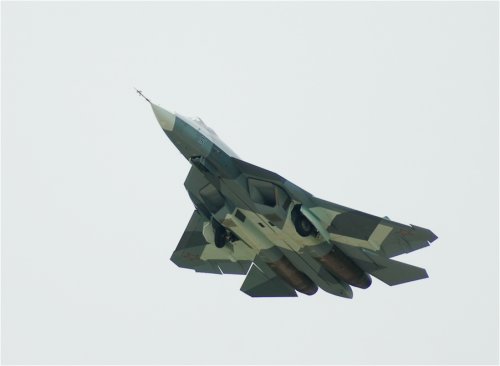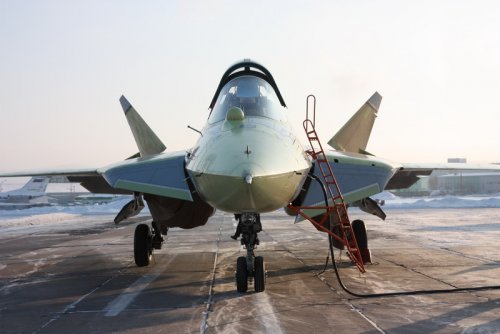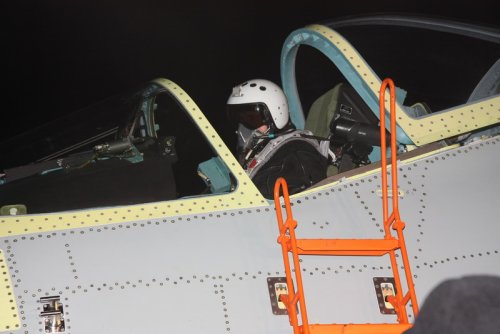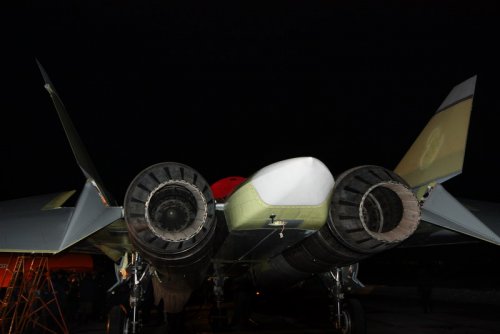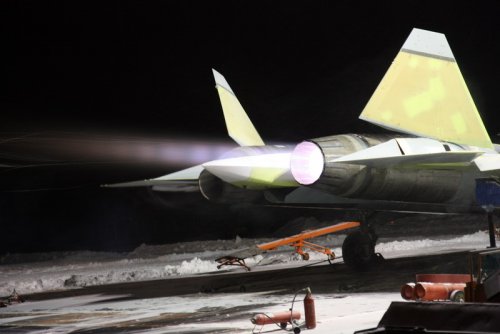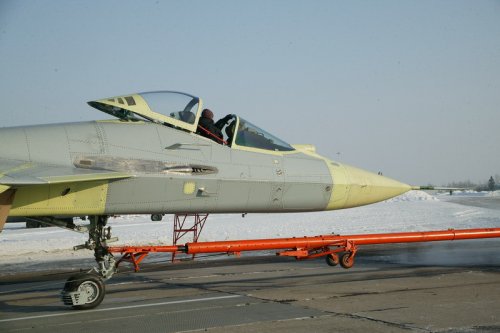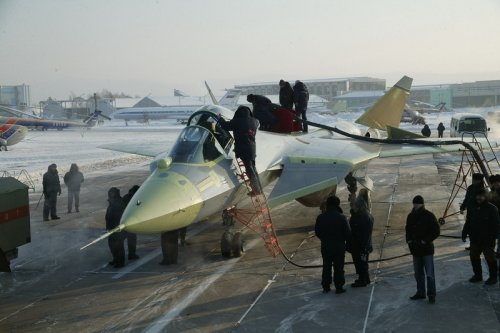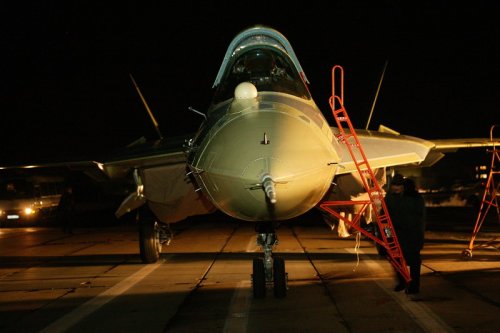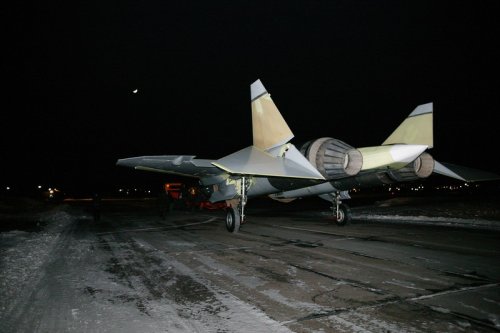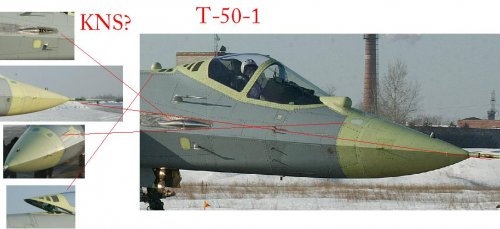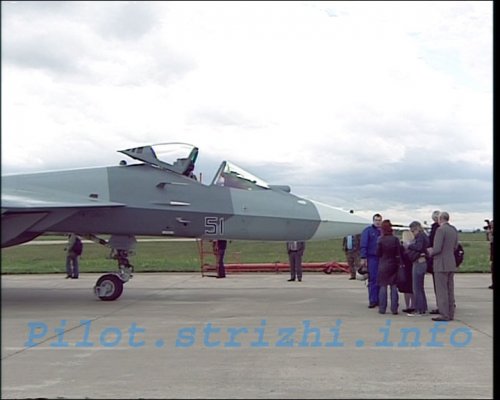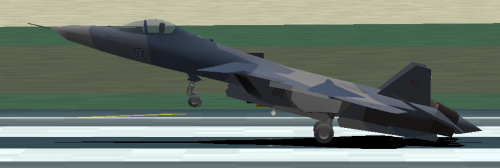You are using an out of date browser. It may not display this or other websites correctly.
You should upgrade or use an alternative browser.
You should upgrade or use an alternative browser.
Sukhoi Su-57 / T-50 / PAK FA - flight testing and development Part I [2010-2012]
- Thread starter Matej
- Start date
- Status
- Not open for further replies.
QuadroFX
Russia, Chelyabinsk
http://www.photosight.ru/users/201232/flanker said:Nice. Taken by who, when?
Link posted by Otaku on Keypubs, KNAAPO website ... 
http://knaapo.ru/rus/gallery/events/combat/t-50/index.wbp
http://knaapo.ru/rus/gallery/events/combat/t-50/index.wbp
Attachments
Dragon029
ACCESS: Top Secret
- Joined
- 17 March 2009
- Messages
- 881
- Reaction score
- 440
I'm just wondering, in this photo the muzzle of the GSH-301 is shown to be open with rings around the opening.
However, in this photo and others it has a cover over it - would this be removed before a combat sortie, opened up mid-flight somehow or just fired through?
Thanks
However, in this photo and others it has a cover over it - would this be removed before a combat sortie, opened up mid-flight somehow or just fired through?
Thanks
- Joined
- 3 June 2006
- Messages
- 3,094
- Reaction score
- 3,964
Well, I presume, that the first prototype doesn't have the gun installed yet. So the just before the aircraft was painted, the muzzle was sealed/covered.
flanker
ACCESS: Top Secret
- Joined
- 20 March 2008
- Messages
- 933
- Reaction score
- 256
I am thinking that some of the recent pictures doesnt show T-50-1, but T-50 KNS. I see several differences:
1: The paint on the rudder differences a bit, you can see a lot of "spots" (repainting) on the tails on the recent pictures. That is not seen on the pictures of T-50-1 in naked version, atleast the spots are not that prominent. The tails also lack sensors, but that might have been added later.
2: The ball behind the cockpit lacks.
3: Gun muzzle cover on T-50-1, but not on the what i presume is KNS.
4: The "glue" on the inside of the canopy on the T-50-1 isnt seen on KNS.
5: Panels on the nose is light grey in recent pictures, but white on T-50-1.
6: Pitot tube is green at the base in the new pictures, metalic/copperish on T-50-1.
Crappy picture without comparing of the fins.
1: The paint on the rudder differences a bit, you can see a lot of "spots" (repainting) on the tails on the recent pictures. That is not seen on the pictures of T-50-1 in naked version, atleast the spots are not that prominent. The tails also lack sensors, but that might have been added later.
2: The ball behind the cockpit lacks.
3: Gun muzzle cover on T-50-1, but not on the what i presume is KNS.
4: The "glue" on the inside of the canopy on the T-50-1 isnt seen on KNS.
5: Panels on the nose is light grey in recent pictures, but white on T-50-1.
6: Pitot tube is green at the base in the new pictures, metalic/copperish on T-50-1.
Crappy picture without comparing of the fins.
Attachments
Remember you can be mislead if you think the new Sukhoi is a subsonic/supersonic dogfighter. This is a Mat Dillon whose goal is draw sooner, faster and at longer range for a first shot kill before you are even in range to draw. Don't believe maximum range numbers for aircraft that can turn away from the engagement after launch. For those an AIM-7 with a 21 to 24 max head-on flight has only a useful, practical head-on engagement range of less than 10 miles. The KEY is the attack system and what controls the missile after launch in this Russian chess game. Remember seldom does the chess master ever enter into combat, that is why he has the chess pieces. Low observables are important but at long ranges less so. Remember who invented the F-117 physical optics theory. It was not us. With our focus that more and more can be done with fewer and fewer combat elements makes us sound more like Hitler and less like the US in WW II or Gengis Khan. When I watch the Science channel or History channel and see the current propaganda movies about the F-22 and F-35 operating with numbers and capabilities that are yet to exist it again reminds me of the wonder weapons that never arrived.
flanker
ACCESS: Top Secret
- Joined
- 20 March 2008
- Messages
- 933
- Reaction score
- 256
sferrin said:Rear of the canopy is the same.
Sundog said:Also, the a2a refueling probe would only be mounted on one side, so I'm not sure what the difference between those two pics is there. The only difference I see, atm, is the faired over gun port.
Read my comments before looking at the picture. I didn't say that the rear canopy is different, i said it is lacking the ball behind the canopy. I am not comparing IFRP placement either, but the panels on the nose.
donnage99
ACCESS: Top Secret
- Joined
- 16 June 2008
- Messages
- 1,355
- Reaction score
- 870
Flanker,
The skin of the panels on the nose reflect light differently from one picture to the next. It's not actually different in color.
The rear of the cockpit has the ball too, but it is outside of the picture frame.
The skin of the panels on the nose reflect light differently from one picture to the next. It's not actually different in color.
The rear of the cockpit has the ball too, but it is outside of the picture frame.
mz said:Do you mean using the tail radar after you've turned away or that other less stealthy platforms that stay far away will be the ones who fire the missiles?
Others than the launch aircraft that may or may not be aircraft. Think od this as a team and the launch aircraft is just one of a number of players that have different jobs to do. This is not two versus two as a tag team match, but two versus the best soccer team around. I see your icon is the NASP government baseline that is 'X' out. From where I was I would have X'd it out if I would have been able
flanker
ACCESS: Top Secret
- Joined
- 20 March 2008
- Messages
- 933
- Reaction score
- 256
donnage99 said:Flanker,
The skin of the panels on the nose reflect light differently from one picture to the next. It's not actually different in color.
Uhm, i disagree. Look at the new pictures. *All* of them (taken in the dark or light) show the panels as light grey, same color as on the airframe grey. The color doesnt vary much depending on the light in the pictures, it is grey either way, not white.
I have also of course thought about that the ball might be hidden due to the angle, but i am not 100 % sure the angle is "bad enough" to hide the ball. It is of course the most simple explanation, but for example this picture is almost same angle (but slightly further away) and show the ball fine.
I think all or almost all pictures of "naked" PAK-FA so far shown were taken 29'th January. But i believe these new pictures are from before 29'th January. So it can either be KNS or T-50-1 in "early" configuration.
PS: I looked through the new pictures in EXIF reader, and they are indeed taken before the first flight.
Attachments
Avimimus
ACCESS: Top Secret
- Joined
- 15 December 2007
- Messages
- 2,426
- Reaction score
- 909
A.F. said:just to refresh memories - there will no be tail radar on T-50
Source? I haven't heard this before.
There is some sort of avionics in the tail (hence the pop up drag shoot release mechanism).
I wouldn't be surprised if there wasn't some sort of short range radar for spotting incoming missiles.
- Joined
- 1 April 2006
- Messages
- 11,394
- Reaction score
- 10,296
Avimimus said:Source? I haven't heard this before.
A.F. conversation with T-50 deputy chief designer during Putin visit to Sukhoi
they decided to drop tail radar as there are many problems with all that stuff
Avimimus
ACCESS: Top Secret
- Joined
- 15 December 2007
- Messages
- 2,426
- Reaction score
- 909
Thanks for the answer. Very interesting.
I wonder if the space will be engineered out of the production version, house extra equipment, or be retained in case sensors or jammers need to be added as part of a mid-life upgrade.
I wonder if the space will be engineered out of the production version, house extra equipment, or be retained in case sensors or jammers need to be added as part of a mid-life upgrade.
Dragon029
ACCESS: Top Secret
- Joined
- 17 March 2009
- Messages
- 881
- Reaction score
- 440
I've been making a PAK-FA model for a free flight sim (YS Flight) and I've always wondered where the tail hook would go, it'd be possible to fit one in the tail, but I'm not sure there'd be enough room for one long enough, replacing the rear bombay with fuel tanks and a tailhook would work perfectly though.
Matej
Multiuniversal creator
Dragon029 said:...it'd be possible to fit one in the tail...
It is absolutely impossible. The structural integrity say NO! Usually the tail hook is connected to the fuselage somewhere in the place of the crossbeams between the engines, where is the point strong enough to sustain forces from the hook landing. Place aft from the second bomb bay is only the additional cover part, added to the main fuselage, so it is not strong enough.
However the idea to cover it inside the rear weapons bay is not bad. If placed in the middle, you can still have some place for the weapons in the sides and the hook itself is perfectly covered from the RCS point of view. On the other side I am not sure, if there are any problems with landing with the bay doors opened.
Matej
Multiuniversal creator
...which is no-no for the carrier landing.
Dragon029
ACCESS: Top Secret
- Joined
- 17 March 2009
- Messages
- 881
- Reaction score
- 440
Ignore my last post, I was basing my view off a quick look at my model with the doors and gears down, on proper inspection it's clear the aircraft would be fine - it may still be dangerous due to other variables but my original thought of the door impacting the deck is pretty much impossible.
My model is still a WIP (such is the nature of the aircraft it's representing) and the program can't simulate the shock-absorbers, but it would still take a rather poor landing for that above scenario to happen:
My model is still a WIP (such is the nature of the aircraft it's representing) and the program can't simulate the shock-absorbers, but it would still take a rather poor landing for that above scenario to happen:
Attachments
flateric said:Avimimus said:Source? I haven't heard this before.
A.F. conversation with T-50 deputy chief designer during Putin visit to Sukhoi
they decided to drop tail radar as there are many problems with all that stuff
can u give to us link where u did read that.
I don't think that they will give up from tail radar
QuadroFX
Russia, Chelyabinsk
http://paralay.iboards.ru/viewtopic.php?p=64469#p64469can u give to us link where u did read that.
I don't think that they will give up from tail radar
saintkatanalegacy
Little Miss Whiffologist
- Joined
- 31 March 2009
- Messages
- 718
- Reaction score
- 17
possible IR turret in the stinger is news to me... B)
Details on FGFA from HAL Chairman interview to Force some excerpts from the interview
What is meant by FGFA’s preliminary design contract being under government approval? Hasn’t the design been frozen by the Russians?
The Russians have already completed 20 flights of their version of FGFA. By government approval we mean the approval to commence the project and the first step would be to sign the Preliminary Design Contract. The exact definition of the scope of activities in the programme and crystallisation of costs and time schedules are expected to take place during the Preliminary Design Phase which is planned to be completed in 18 months. At present, the aircraft has not been frozen into its final configuration.
The Indian Air Force will have certain requirements of its own which will be put across to the Russians and they in turn will share all the design parameters with us that have been done so far. Once the IAF-specific requirements have been spelt out, they will be considered and dovetailed into the preliminary design; it would then be frozen and feasibility studies would be done and the final configuration of FGFA will be established through development flights.
Let me emphasise at this point, the understanding is that all aspects of the FGFA design will be shared by the Russians. I would like to point out that we have never done a programme of this magnitude before. The Russians hope to develop their aircraft by 2015 and after that our (IAF) special requirements will be met for the Indian FGFA which is planned for induction from 2018.
What will be the high-point of FGFA?
The ultimate attribute of FGFA would be its stealth capability. In addition, it will feature supersonic cruise, ultra-manoeuvrability, highly integrated avionics suite, internal carriage of weapons, network centric warfare capabilities etc.
Considering that Su-30MKI is being talked off as fourth generation plus aircraft, how different will FGFA be from this?
FGFA will be a much superior aircraft when compared to the Su-30 MKI. Su-30 aircraft does not have stealth feature and the other fifth generation capabilities as mentioned earlier. FGFA will be able to fire the latest Beyond Visual Range (BVR) missiles. I must point out that we will have a significant contribution to make in the FGFA programme. For example, there are six indigenous avionics systems in Su-30MKI which incidentally have also been accepted by the Algerian Air Force on their Su-30 aircraft. These systems will also be there in the FGFA. We are hopeful to contribute in the area of composites as well.
How sure are we that the Russians indeed have the capability of producing the FGFA, after all, this will be the second FGFA in the world after the US’ Raptor programme?
The Raptor of the US is a reality while the Russian FGFA is still in the preliminary stages. The other FGFA which is under development by the US and eight participating countries is the Joint Strike Fighter (F-35). We have to understand two aspects about the Indo-Russian FGFA programme. First, its development cost will be much lower than the Raptor and second, US is unlikely to share its fifth generation aircraft technology with other countries. In this scenario, the joint Indo-Russia FGFA is the best option available to us.
When do you expect the FGFA preliminary design contract to be signed and who will be the parties involved?
The FGFA preliminary design contract should be signed by the end of this year. From their side, the signatories will be Rosoboronexport and Sukhoi Design Bureau and from our side it will be HAL.
What a letdown: in the latest issue of "Lotnictwo"(Aviation), Piotr Butowski quotes some top Russian brass, saying they intend to order only SIXTY examples of PAK FA, which contradicts previous declarations of 250 examples to be purchased for the VVS. Another new thing to me: the ball-shaped sensor in front of the windscreen and just aft of the canopy are part of the "Atoll" system, the third, look-down sensor will be probably carried in a pod. The LERXes are attached to what Piotr calls the wing and what to me seems to be the top of the air intake by means of a flexible joint. The weapons bay capacity is disappointing: only two K-77M air-to-air missiles per bay or one Kh-38Ushk(anti-radiation)/Kh-38M(general purpose air-to-ground)/KAB-500S/KAB-500M per bay. Plus two K-74M short-range AAMs in "fast" pods under the wings and any ordnance carried optionally on four unstealthy, underwing pylons, including upgraded versions of Kh-35, Kh-31 and Kh-59. All this armoury is to be replaced by entirely new weapons in the distant future.
Avimimus
ACCESS: Top Secret
- Joined
- 15 December 2007
- Messages
- 2,426
- Reaction score
- 909
Interesting - so one 700kg launchers per bay and two 300kg launchers (as discussed on Paralay's boards)? It would be interesting to confirm that weapons can't be simultaneously carried on both sets of launchers. Anyway, the strike capability is still superior to the F/A-22, but is insufficient for the design to be used as the primary tactical bomber.
I wouldn't be surprised if the limited orders aren't intended to support the development of the 2nd generation derivative of this aircraft with more powerful engines. Given the difficulties developing completely new platforms, the experience with growing the Su-35 out of the Su-27 is a positive one. It seems very likely that the engines are only the beginning and the airframe has been designed with a higher than average amount of development potential.
What do you think? The decision to have the look down sensor in a separate pod breaks with Russian tradition, but may be intended to optimise the air-to-air configuration or decrease RCS against long-range SAM systems.
P.S. Foxglove - if you can get me the full reference for the issue, I'll pop down to the Wikipedia and correct the entry before the excessive weapons load becomes an "internet fact".
I wouldn't be surprised if the limited orders aren't intended to support the development of the 2nd generation derivative of this aircraft with more powerful engines. Given the difficulties developing completely new platforms, the experience with growing the Su-35 out of the Su-27 is a positive one. It seems very likely that the engines are only the beginning and the airframe has been designed with a higher than average amount of development potential.
What do you think? The decision to have the look down sensor in a separate pod breaks with Russian tradition, but may be intended to optimise the air-to-air configuration or decrease RCS against long-range SAM systems.
P.S. Foxglove - if you can get me the full reference for the issue, I'll pop down to the Wikipedia and correct the entry before the excessive weapons load becomes an "internet fact".
saintkatanalegacy
Little Miss Whiffologist
- Joined
- 31 March 2009
- Messages
- 718
- Reaction score
- 17
IMHO, they are being realistic and money wise in the process.
60 initial frames with the first set of engines
followed by
190 frames with the 2nd set of engines
this would ease the manufacturing process and at lower cost and design risks involved
regarding the K-77m et al, they did mention that they're going to replace them...
possibly with a folding version for the K-77m
I'd say they're just being cautious.
the third sensor I reckon would be...
here

60 initial frames with the first set of engines
followed by
190 frames with the 2nd set of engines
this would ease the manufacturing process and at lower cost and design risks involved
regarding the K-77m et al, they did mention that they're going to replace them...
possibly with a folding version for the K-77m
I'd say they're just being cautious.
the third sensor I reckon would be...
here
All Roadblocks Removed, 5th Gen Fighter Agreement Soon: Defence Minister
“As per this agreement India will receive approximately between 250-300 most modern FGFA.
- Joined
- 1 April 2006
- Messages
- 11,394
- Reaction score
- 10,296
Foxglove said:What a letdown: in the latest issue of "Lotnictwo"(Aviation)
PB comments on this with something like "it's interesting how actual text is being misinterpreted after translation"
60 PAK FAs - but this number should go in inventory before 2020, none said that there will be no more orders after that time
and two, not one Kh-38s or Kh-58USHKs per bay
Avimimus
ACCESS: Top Secret
- Joined
- 15 December 2007
- Messages
- 2,426
- Reaction score
- 909
Ah... Is it hinging on the word translated as "bay"?
Does this mean that they're planning on packing in a total of eight R-77 successors - or will there be only four 700kg hardpoints/launchers? I'm curious about Piotr Butowski's source. It would be nice to have more hard data on this platform's "teeth".
Does this mean that they're planning on packing in a total of eight R-77 successors - or will there be only four 700kg hardpoints/launchers? I'm curious about Piotr Butowski's source. It would be nice to have more hard data on this platform's "teeth".
Matej
Multiuniversal creator
Foxglove said:Plus two K-74M short-range AAMs...
As far as I know, R-74 (izdelije 740) and R-74M (izdelije 750) never went into the serial production. PAK FA will be equipped with the RVV-MD (izdelije 760) - something like the most modern derivate of the R-73 and later with the fundamentally new K-MD (izdelije 300).
Avimimus
ACCESS: Top Secret
- Joined
- 15 December 2007
- Messages
- 2,426
- Reaction score
- 909
It is interesting to speculate on the K-MD - the length of the side bays might fit a medium range (ie. 40km - to take advantage of better IR sensors) dogfight missile - like a smaller RVV-AE with thrust vectoring. Although such speculations are otherwise idle guesswork.
It is a simple deductive error based on trying to get the most from limited information: 1) The bays have enough volume for two 700kg missiles 2) It is suggested that only one 700kg missiles or two R-77 are carried per bay 3) This fits one of the Paralay speculations with one UVKU-50U in the centre of the bay, flanked by two UVKU-50L 4) This is discarded as Flateric reports an error in translation 5) I guess that "door" was confused with "bay" by the translators 6) which suggests that the translation of two K-77 per bay, might be per door, implying eight 300kg missiles replacing four 700kg ones 7) or alternatively that the two K-77 per bay report indicates that the K-77 would be carried on the UVKU-50U. Dizzy yet?
Personally I could never make sense of what the UVKU-50L's were four (unless the missiles in the pods are high diametre or it is simply a way to hedge bets by providing internal launchers for all classes of missiles) nor could I make sense of the ten internal bombs or ten internal missiles claims. There just doesn't seem to be enough volume (without the engineers getting excessively clever).
...and we can all see where trying to be too clever leads...
flateric said:Frankly I don't understand how corrected information about four Kh-38 or Kh-58 inside bays rapidly transformed in 'eight R-77s' in your head
It is a simple deductive error based on trying to get the most from limited information: 1) The bays have enough volume for two 700kg missiles 2) It is suggested that only one 700kg missiles or two R-77 are carried per bay 3) This fits one of the Paralay speculations with one UVKU-50U in the centre of the bay, flanked by two UVKU-50L 4) This is discarded as Flateric reports an error in translation 5) I guess that "door" was confused with "bay" by the translators 6) which suggests that the translation of two K-77 per bay, might be per door, implying eight 300kg missiles replacing four 700kg ones 7) or alternatively that the two K-77 per bay report indicates that the K-77 would be carried on the UVKU-50U. Dizzy yet?
Personally I could never make sense of what the UVKU-50L's were four (unless the missiles in the pods are high diametre or it is simply a way to hedge bets by providing internal launchers for all classes of missiles) nor could I make sense of the ten internal bombs or ten internal missiles claims. There just doesn't seem to be enough volume (without the engineers getting excessively clever).
...and we can all see where trying to be too clever leads...
Avivimus, my source is an article by Piotr Butowski entitled 'What's new in the PAK FA program?' in the October issue of 'Lotnictwo', pp.54-59. The information about sixty examples of T-50 to be purchased by the VVS by 2020, according to PB, came from the commander-in-chief of the Russian Air Force, General Alexander Zielin. For me it's a disappointment, as I doubt for a number of reasons that more examples will be acquired after that date to make the 250 airframes quota mentioned before by Russian sources. So sixty aircraft is probably the most realistic prediction, though chances are that India will stick to its initial pledge of 250.
PB writes that 'each bay can carry two large rockets or bombs', which could translate into four Kh-38, KABs or K-77M, or a mix of these
Matej, I didn't say K-77M was series produced, PB writes it is being tested now and is to enter series production soon, while K-74M2 is still in its design stage.
Interestingly, the three 'Atoll' sensors are passive-active IR, and can track and guide an unspecified number of AA and air-to-ground missiles. The self-defence system will probably include the five antennas of the Sh121 radar system, as well as 'Atoll' and laser sensors, covering 360 degrees in azimuth.
PB writes that 'each bay can carry two large rockets or bombs', which could translate into four Kh-38, KABs or K-77M, or a mix of these
Matej, I didn't say K-77M was series produced, PB writes it is being tested now and is to enter series production soon, while K-74M2 is still in its design stage.
Interestingly, the three 'Atoll' sensors are passive-active IR, and can track and guide an unspecified number of AA and air-to-ground missiles. The self-defence system will probably include the five antennas of the Sh121 radar system, as well as 'Atoll' and laser sensors, covering 360 degrees in azimuth.
- Status
- Not open for further replies.
Similar threads
-
Sukhoi Su-57 flight testing, development & operations [2012-current]
- Started by overscan (PaulMM)
- Replies: 4K
-
Sukhoi Su-57 / T-50 / PAK FA first flight - pictures, videos and analysis [2010]
- Started by flateric
- Replies: 872
-
Sukhoi PAK FA news and speculation (T-50, I-21) Part II [2008-2009]
- Started by overscan (PaulMM)
- Replies: 451
-
Sukhoi PAK FA news and speculation (T-50, I-21) Part I [2006-2008]
- Started by overscan (PaulMM)
- Replies: 455
-
Vladimir Sergeevich Ilyushin 31-03-1927 - 01-03-2010
- Started by flateric
- Replies: 4

